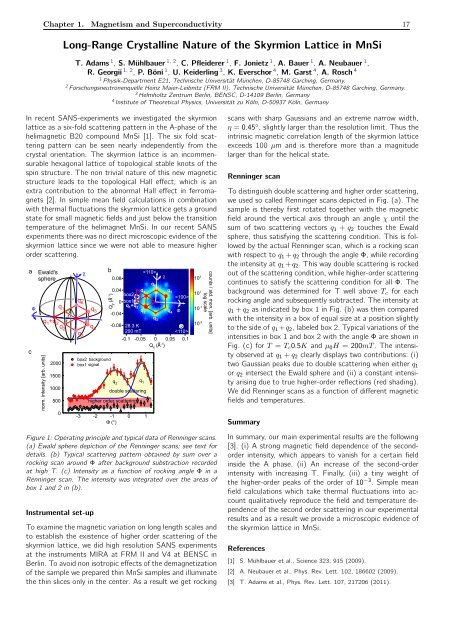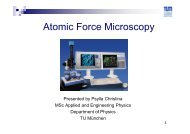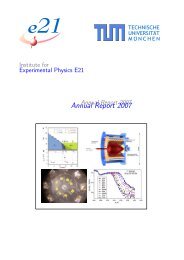Annual Report 2011 / 2012 - E21 - Technische Universität München
Annual Report 2011 / 2012 - E21 - Technische Universität München
Annual Report 2011 / 2012 - E21 - Technische Universität München
You also want an ePaper? Increase the reach of your titles
YUMPU automatically turns print PDFs into web optimized ePapers that Google loves.
counts / std. mon. [arb. units]<br />
log scale<br />
Chapter 1. Magnetism and Superconductivity 17<br />
Long-Range Crystalline Nature of the Skyrmion Lattice in MnSi<br />
T. Adams 1 , S. Mühlbauer 1, 2 , C. Pfleiderer 1 , F. Jonietz 1 , A. Bauer 1 , A. Neubauer 1 ,<br />
R. Georgii 1, 2 , P. Böni 1 , U. Keiderling 3 , K. Everschor 4 , M. Garst 4 , A. Rosch 4<br />
1 Physik-Department <strong>E21</strong>, <strong>Technische</strong> Universität München, D-85748 Garching, Germany.<br />
2 Forschungsneutronenquelle Heinz Maier-Leibnitz (FRM II), <strong>Technische</strong> Universität München, D-85748 Garching, Germany.<br />
3 Helmholtz Zentrum Berlin, BENSC, D-14109 Berlin, Germany<br />
4 Institute of Theoretical Physics, Universität zu Köln, D-50937 Köln, Germany<br />
In recent SANS-experiments we investigated the skyrmion<br />
lattice as a six-fold scattering pattern in the A-phase of the<br />
helimagnetic B20 compound MnSi [1]. The six fold scattering<br />
pattern can be seen nearly independently from the<br />
crystal orientation. The skyrmion lattice is an incommensurable<br />
hexagonal lattice of topological stable knots of the<br />
spin structure. The non trivial nature of this new magnetic<br />
structure leads to the topological Hall effect, which is an<br />
extra contribution to the abnormal Hall effect in ferromagnets<br />
[2]. In simple mean field calculations in combination<br />
with thermal fluctuations the skyrmion lattice gets a ground<br />
state for small magnetic fields and just below the transition<br />
temperature of the helimagnet MnSi. In our recent SANS<br />
experiments there was no direct microscopic evidence of the<br />
skyrmion lattice since we were not able to measure higher<br />
order scattering.<br />
a<br />
c<br />
Ewald's<br />
sphere<br />
Φ q 1<br />
q 1<br />
+q 2<br />
q 2<br />
norm. intensity [arb. units]<br />
2000<br />
1500<br />
1000<br />
500<br />
0<br />
q 6<br />
χ<br />
q 5<br />
q 3<br />
q 4<br />
b<br />
<br />
χ<br />
1.7 x 10<br />
0.08<br />
10 3<br />
3<br />
q 6<br />
10<br />
0.04 q 1 q 31<br />
2<br />
5<br />
box2<br />
10 1<br />
<br />
0 box1<br />
10 5.7 0<br />
x 10 -1<br />
q 1 +q 2<br />
q 2 q 4 Φ<br />
10 -1<br />
-0.04<br />
1.1 x 10 -2<br />
q 3<br />
Q y (Å -1 )<br />
box2 background<br />
box1 signal<br />
-0.08<br />
28.3 K<br />
200 mT<br />
-3 -2 -1 0 1<br />
Φ (°)<br />
<br />
-0.1 -0.05 0 0.05 0.1<br />
Q x (Å -1 )<br />
q 2<br />
q 1<br />
double scattering<br />
higher order scattering<br />
10 -2<br />
10 -3<br />
2.0 x 10 -4<br />
Figure 1: Operating principle and typical data of Renninger scans.<br />
(a) Ewald sphere depiction of the Renninger scans; see text for<br />
details. (b) Typical scattering pattern obtained by sum over a<br />
rocking scan around Φ after background substraction recorded<br />
at high T. (c) Intensity as a function of rocking angle Φ in a<br />
Renninger scan. The intensity was integrated over the areas of<br />
box 1 and 2 in (b).<br />
Instrumental set-up<br />
To examine the magnetic variation on long length scales and<br />
to establish the existence of higher order scattering of the<br />
skyrmion lattice, we did high resolution SANS experiments<br />
at the instruments MIRA at FRM II and V4 at BENSC in<br />
Berlin. To avoid non isotropic effects of the demagnetization<br />
of the sample we prepared thin MnSi samples and illuminate<br />
the thin slices only in the center. As a result we get rocking<br />
10 -4<br />
scans with sharp Gaussians and an extreme narrow width,<br />
η = 0.45 ◦ , slightly larger than the resolution limit. Thus the<br />
intrinsic magnetic correlation length of the skyrmion lattice<br />
exceeds 100 µm and is therefore more than a magnitude<br />
larger than for the helical state.<br />
Renninger scan<br />
To distinguish double scattering and higher order scattering,<br />
we used so called Renninger scans depicted in Fig. (a). The<br />
sample is thereby first rotated together with the magnetic<br />
field around the vertical axis through an angle χ until the<br />
sum of two scattering vectors q 1 + q 2 touches the Ewald<br />
sphere, thus satisfying the scattering condition. This is followed<br />
by the actual Renninger scan, which is a rocking scan<br />
with respect to q 1 +q 2 through the angle Φ, while recording<br />
the intensity at q 1 +q 2 . This way double scattering is rocked<br />
out of the scattering condition, while higher-order scattering<br />
continues to satisfy the scattering condition for all Φ. The<br />
background was determined for T well above T c for each<br />
rocking angle and subsequently subtracted. The intensity at<br />
q 1 +q 2 as indicated by box 1 in Fig. (b) was then compared<br />
with the intensity in a box of equal size at a position slightly<br />
to the side of q 1 +q 2 , labeled box 2. Typical variations of the<br />
intensities in box 1 and box 2 with the angle Φ are shown in<br />
Fig. (c) for T = T c 0.5K and µ 0 H = 200mT. The intensity<br />
observed at q 1 +q 2 clearly displays two contributions: (i)<br />
two Gaussian peaks due to double scattering when either q 1<br />
or q 2 intersect the Ewald sphere and (ii) a constant intensity<br />
arising due to true higher-order reflections (red shading).<br />
We did Renninger scans as a function of different magnetic<br />
fields and temperatures.<br />
Summary<br />
In summary, our main experimental results are the following<br />
[3]. (i) A strong magnetic field dependence of the secondorder<br />
intensity, which appears to vanish for a certain field<br />
inside the A phase. (ii) An increase of the second-order<br />
intensity with increasing T. Finally, (iii) a tiny weight of<br />
the higher-order peaks of the order of 10 −3 . Simple mean<br />
field calculations which take thermal fluctuations into account<br />
qualitatively reproduce the field and temperature dependence<br />
of the second order scattering in our experimental<br />
results and as a result we provide a microscopic evidence of<br />
the skyrmion lattice in MnSi.<br />
References<br />
[1] S. Mühlbauer et al., Science 323, 915 (2009).<br />
[2] A. Neubauer et al., Phys. Rev. Lett. 102, 186602 (2009).<br />
[3] T. Adams et al., Phys. Rev. Lett. 107, 217206 (<strong>2011</strong>).




